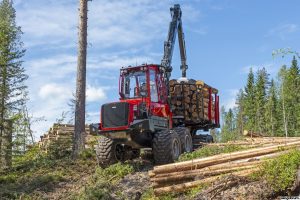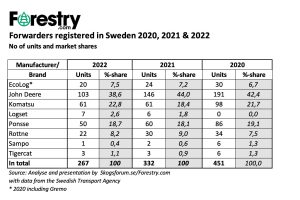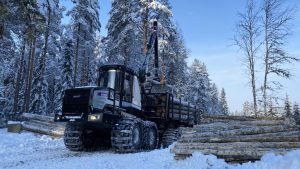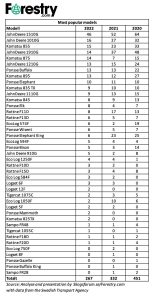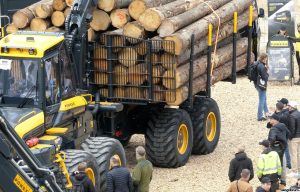The sister site Skogsforum.se collects registration data* on the number of delivered forwarders on the Swedish market. It’s a bleak read even if the market recovered to some extent by the end of the year. 267 newly registered forwarders with a payload of over 8 tons in Sweden in 2022 is one of the lowest figures in decades.
The Swedish forwarder market 2022
The reason for the poor year is not a decreasing market but disruptions in the component supply chain. The forest machine manufacturers have had full order books but the deliveries of ordered machines have been delayed due to the lack of components.
Almost down to the level of the financial crisis in 2009
The average number of registered forwarders in Sweden in the last 10 years is 320. But during the last five years (2017 – 2021) the average number was 349 forwarders. The top year was 2020 with 451 registered forwarders.
The increasing need for forest machinery is most likely due to the increasing felling in Sweden. But, as mentioned above was the number for 2022 only 267 forwarders which is significantly fewer than in many years. As a comparison, 258 forwarders were delivered in 2009 when the financial crisis struck all businesses globally.
The development of the Swedish market during 2022 started weakly with 50 – 60 registered forwarders during Q1, Q2, and Q3. During Q4 something happened and over 100 forwarders were registered. That is more like what we are used to and perhaps an indicator that the manufacturers start to get the supply chains in order again.
No decrease in interest among buyers
The low number of registered forwarders can’t be explained by the upcoming recession, increasing inflation, or increased interest rates. The machine manufacturers have had lots of orders and delivery times of over a year. Almost all machines that were delivered in 2022 were ordered in 2021.
During the crisis in 2009, many machine orders were canceled. This has not happened in 2022 according to the manufacturers. The only reason for the low figures in 2022 that is referred to, is the supply problems. E.g., the market leader John Deere Forestry suffered at the beginning of 2022 from that their sub-supplier of loaders got its factory destroyed by a fire which led to a total production stop for a few months.
Other bottlenecks have been delayed deliveries of electronic and hydraulic components. The new Komatsu Forests factory in Umeå, has been surrounded by a “red ocean” of almost ready machines waiting for the last few components before delivery. One can easily imagine the frustration among both manufacturers and customers.
Photo: Komatsuforest.se
The market shares
It’s difficult to make any clear conclusions about changes in market shares in a year like 2022. The differences reflect the manufacturers’ ability to get components more than the customers’ choice of brand and size of the machine.
Nevertheless, we will present the result of the Swedish forwarder market based on the number of registered forwarders*.
Source: Swedish Transport Agency, compiled by Skogsforum.se
The difference in market shares between the brands is relatively stable during 2020, 2021, and 2022 as you can see in the table here above. John Deere has lost some shares, probably due to the fire in the loader factory, and Logset snaps another few percent of the Swedish market. Sampo seems to have had a slower year compared to their average. Here it should be mentioned that Sampo for some reason often registers their forwarders quite late.
Photo: Logset.fi
Most popular models
At the top of the list of most popular forwarder models, we still find John Deere’s 1510G. In the second place there is also a green machine, the John Deere 101G which has removed the 1910G from that position from last year. The John Deere 1910G has been in number two both in 2020 and 2021 but now ends up in fourth place which it shares with Komatsu 875.
The Komatsu’s 875 and 855 are two climbers on the list. 855 in third and 875 in fourth place. Twice as many Komatsu 875 were sold in 2022 compared to 2021.
Source: Swedish Transport Agency, compiled by Skogsforum.se
One large forwarder that has lost greatly is the Ponsse Elephant King. It went from fourth place in 2021 to eighteenth in 2022. Either the Ponsse factory has prioritized other models, or the customers are waiting for the new Ponsse Mammoth forwarder to hit the market. The Mammoth was launched together with the harvester Scorpion Giant last summer.
Photo: Torbjörn Johnsen
Two smaller forwarders that lost some market shares are Rottne F11D and EcoLog 1050F. The F11D went from 17 registered in 2021 to 8 in 2022. The 1050F went from 10 to 2 between 2021 and 2022. Komatsu, on the other hand, has kept the position for the 835TX and registered the first machines of the new 825TX model. John Deere’s smallest, the 910G, also has increased in the number of registrations.
As mentioned above, the 2022 list is affected more by the manufacturers’ ability to get components than the customers’ choice of brand.
What about the future?
Skogsforum.se has spoken to some of the Swedish suppliers of forest machines and the image is clear. The market is difficult to predict but in short term, the machines must run more hours before they are replaced by new ones. The problems with component supplies have forced the development in that direction in 2022. The general increase in costs most likely contributes to that the contractors must squeeze more hours out of each machine before a new one is ordered.
Maintenance and breakdowns on the machines increase as the machines get older but compared to a machine switch the calculation has changed. As good as everything is more expensive now. This makes a new machine more expensive. In addition to that, the financing costs increase due to higher interest rates.
To cope with higher costs, keep the machine fleet fresh, offer good conditions for the staff, and be competitive the payment to the contractors must increase. This demands higher wood prices for the forest owners. Several machine manufacturers have 2021 and 2022 described the situation for Swedish customers as worse than for customers in Central Europe and North America. Contractors in other countries are simply better-paid thanks to higher timber prices than in Sweden.
“Even if there is a theoretically pent-up need for new machines there has by the end of 2022 been some hesitation from the customers,” says Henrik Johansson, CEO at John Deere Forestry Sweden. “In the last few weeks, the desire to invest seems to have returned.”
Maybe the higher pulpwood prices lately have contributed to increased optimism. We will see in what direction the development will go in 2023.
* In Sweden, all forwarders are registered by the authority Swedish Transport Agency (Transportstyrelsen) at delivery. As the Swedish market for CTL machines** is the largest in the World (2022), those figures give a fairly good picture of the total market for CTL machines. The harvesters are, however, not registered by the Transport Agency, but the number of manufactured harvesters follows the number of forwarders in most cases.
This article is based on figures from the Swedish Transport Agency’s forwarder registrations and has been analyzed and compiled by Skogsforum.se.
** CTL = Cut-To-Length is a system based on two machines: one harvester that fells and cuts the trees into lengths at the stump in the forest, and a forwarder that brings the timber to roadside. This is the type of machines that are manufactured and used in the Nordic Countries. The CTL technology is gaining market share globally and is today used in more than half of the World´s felling operations. Most manufacturers of CTL machines are located in Sweden and Finland.






